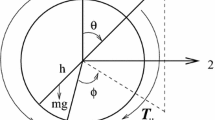Abstract
Bioconvection occurs as the result of the collective behaviour of many microorganisms swimming in a fluid and is realized as patterns similar to those of thermal convection which occur when a layer of fluid is heated from below. We consider the phenomenon of pattern formation due to gyrotaxis, an orientation mechanism which results from the balance of gravitational and viscous torques acting on bottom-heavy micro-organisms. The continuum model of Pedley et al. (1988, J. Fluid. Mech. 195, 223–237) is used to describe the suspension. The system is governed by the Navier-Stokes equations for an incompressible fluid coupled with a micro-organism conservation equation. These equations are solved numerically using a conservative finite-difference scheme. To examine the dependence of the horizontal pattern wavelengths on the parameters, we consider two-dimensional solutions in a wide chamber using rigid side walls. The wavelengths of the numerical computations are in good agreement with the experimental observations and we provide the first computational examples of the commonly seen ‘bottom-standing’ plumes.
Similar content being viewed by others
References
Batchelor, G. K. (1970). The stress system in a suspension of force-free particles. J. Fluid Mech. 41, 545–570.
Bees, M. A. and N. A. Hill (1997). Wavelengths of bioconvection patterns. J. Exp. Biol. 200, 1515–1526.
Bees, M. A., N. A. Hill and T. J. Pedley (1998). Analytical approximations for the orientation distribution of small dipolar particles in steady shear flows. J. Math. Biol. 36, 269–298.
Childress, S., M. Levandowsky and E. A. Spiegel (1975). Pattern formation in a suspension of swimming micro-organisms: equations and stability theory modes. J. Fluid Mech. 69, 595–613.
Childress, S. and R. Peyret (1976). A numerical study of two-dimensional convection by motile particles. J. Mécanique 15, 753–779.
De Vahl Davis, G. (1983). Natural-convection of air in a square cavity—a bench-mark numerical-solution. Int. J. Numer. Methods Fluids 3, 249–264.
Ghorai, S. (1997). Bioconvection and plumes, PhD thesis, University of Leeds, UK.
Ghorai, S. and N. A. Hill (1999). Development and stability of gyrotactic plumes in bioconvection. J. Fluid Mech. 400, 1–31.
Ghorai, S. and N. A. Hill (2000). Periodic arrays of gyrotactic plumes in bioconvection. Phys. Fluids 12, 5–22.
Harashima, A., M. Watanabe and I. Fujishiro (1988). Evolution of bioconvection patterns in a culture of motile flagellates. Phys. Fluids. 31, 764–775.
Hill, N. A. and D.-P. Häder (1997). A biased random walk model for the trajectories of swimming micro-organisms. J.Theor. Biol. 186, 503–526.
Hill, N. A., T. J. Pedley and J. O. Kessler (1989). Growth of bioconvection patterns in a suspension of gyrotactic micro-organisms in a layer of finite depth. J. Fluid Mech. 208, 509–543.
de Rivas, K. (1972). On the use of nonuniform grids in finite-difference equations. J. Comput. Phys. 10, 202–210.
Kessler, J. O. (1984). Gyrotactic buoyant convection and spontaneous pattern formation in algal cell cultures, in Non-Equilibrium Cooperative Phenomena in Physics and Related Fields, M. G. Velarde (Ed.), New York: Plenum Press, pp. 241–248.
Kessler, J. O. (1985a). Hydrodynamic focusing of motile algal cells. Nature 313, 218–220.
Kessler, J. O. (1985b). Co-operative and concentrative phenomena of swimming microorganisms. Contemp. Phys. 26, 147–166.
Kessler, J. O. (1986). Individual and collective fluid dynamics of swimming cells. J. Fluid Mech. 173, 191–205.
Lennie, T. B., D. P. McKenzie, D. R. Moore and N. O. Weiss (1988). The breakdown of steady convection. J. Fluid Mech. 188, 47–85.
Loeffer, J. B. and R. B. Mefferd (1952). Concerning pattern formation by free-swimming microorganisms. Am. Nat. 86, 325–329.
Pedley, T. J. and J. O. Kessler (1987). The orientation of spheroidal micro-organisms swimming in a flow field. Proc. R. Soc. Lond. Ser. B 231, 47–70.
Pedley, T. J. (1988). Bottom-standing plumes in gyrotactic bioconvection. Bull. Am. Phys. Soc. 33, 2282 (Abstract).
Pedley, T. J. and J. O. Kessler (1990). A new continuum model for suspensions of gyrotactic micro-organisms. J. Fluid Mech. 212, 155–182.
Pedley, T. J. and J. O. Kessler (1992). Hydrodynamic phenomena in suspensions of swimming micro-organisms. Ann. Rev. Fluid Mech. 24, 313–358.
Pedley, T. J., N. A. Hill and J. O. Kessler (1988). The growth of bioconvection patterns in a uniform suspension of gyrotactic micro-organisms. J. Fluid Mech. 195, 223–237.
Platt, J. R. (1961). ’Bioconvection patterns’ in cultures of free-swimming organisms. Science 133, 1766–1767.
Plesset, M. S. and H. Winet (1974). Bioconvection patterns in swimming microorganism cultures as an example of Rayleigh-Taylor instability. Nature 248, 441–443.
Roberts, G. O. (1970). Computational meshes for boundary layer problems, Second International Conference on Numerical Methods in Fluid Dynamics, Lecture Notes in Physics, M. Holt (Ed.), 8, New York: Springer, pp. 171–177.
Wager, H. (1911). On the effect of gravity upon the movements and aggregation of Euglena viridis, Ehrb., and other micro-organisms. Phil. Trans. R. Soc. Lond. Ser. B 201, 333–390.
Wille, J. J. and C. F. Ehret (1968). Circadian rhythm of pattern formation in population of a free-swimming organism, Tetrahymena. J. Protozool. 15, 789–792.
Author information
Authors and Affiliations
Corresponding author
Rights and permissions
About this article
Cite this article
Ghorai, S., Hill, N.A. Wavelengths of gyrotactic plumes in bioconvection. Bull. Math. Biol. 62, 429–450 (2000). https://doi.org/10.1006/bulm.1999.0160
Received:
Accepted:
Issue Date:
DOI: https://doi.org/10.1006/bulm.1999.0160




